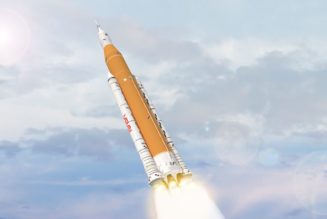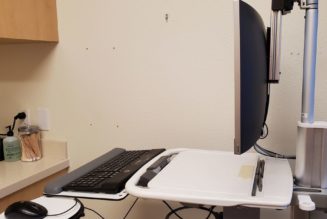The NASA spacecraft that snatched a sample of rocks from the distant Bennu asteroid last year fired up a suite of thrusters on Monday and committed to its two-year journey back home. The maneuver kicks the minivan-sized spacecraft, dubbed Osiris-REx, onto a winding cosmic path around the Sun and toward Earth’s orbit. When it returns to Earth in 2023, it’ll toss a capsule packed with asteroid samples through the atmosphere somewhere over Utah.
The spacecraft’s Asteroid Departure Maneuver (ADM) was no sweat for the Osiris-REx team, but it marked a significant step towards the return of the first pristine cache of asteroid samples in NASA’s history. Spacecraft engineers inside a Lockheed Martin center in Littleton, Colorado confirmed the seven-minute thruster firing began at 4PM ET Monday and celebrated success shortly after.
“All stations, the ADM burn has completed. We had a nominal ADM burn, and we’re bringing our samples home!” declared Navigation Team Chief Pete Antreasian, prompting applause inside the control room.
Osiris-REx launched from Florida in 2016 to journey over 100 million miles to Bennu, an acorn-shaped asteroid named after a mythological Egyptian deity that symbolized the world’s creation. Scientists hope Bennu, an ancient remnant from the earliest days of the solar system, will hold clues to the origins of life on Earth.
Last year, Osiris-REx entered Bennu’s orbit, becoming the first US spacecraft to circle an asteroid. It gradually approached the space rock’s surface and extended an 11-foot robotic arm with a showerhead-shaped collection device on the end. In a dramatic event that lasted only a few seconds, the sampling head touched down on Bennu’s surface and emitted a blast of pressurized gas strong enough to kick up rocks and asteroid debris to catch them in the sampling head’s container. Bennu’s surface was surprisingly soft, and the touch-and-go maneuver splashed up more rocks than scientists expected. The asteroid scoop was so hearty — collecting about two ounces — that rocks jammed the sampling container door open.

But engineers managed to close up the rock suitcase and stow it safely inside the spacecraft’s capsule. Osiris-REx stayed in Bennu’s neighborhood for a few more months to bask in the cloud of asteroid dust it punched up, and to study the crater it left on the asteroid’s surface. Now, it’s finally on its way home.
“It’s a new chapter in the mission,” says Osiris-REx project scientist Jason Dworkin, who maintains the scientific integrity of the sampling mission, serving as the operational glue between the spacecraft engineering team and the teams of scientists eagerly awaiting the asteroid samples. “I’ve been waiting a long time to get this sample to the laboratory,” he tells The Verge. “I started in 2004. My daughter was in diapers, and now she’s graduating from high school.”
The first thruster burn on Monday was precisely timed to put Osiris-REx in Earth’s path two and a half years from now, a little over 6,000 miles from the surface. The spacecraft will orbit the Sun twice along the way, using its thrusters to intricately nudge itself closer and closer to Earth and tallying 1.4 billion miles total in its return expedition. “This is really the finality — we’re done at Bennu, we aren’t going back,” says Sandy Freund, Lockheed Martin’s Osiris-REx Mission Operations Program Manager. “There’s a little bit of sadness, in that we’ve gotten to know this asteroid, we’ve learned so much. But then there’s that excitement of what we’re going to learn when these samples are here on Earth.”
The spacecraft will eject its dishwasher-sized asteroid sample capsule and send it careening through Earth’s atmosphere for a landing at the Utah Test and Training Range on September 24th, 2023. Osiris-REx will stay in space. If it manages to save enough fuel during its years-long return from Bennu, NASA might assign it a new mission to another asteroid sometime in the future, the agency said in a blog post on Monday.
As soon as it touches down in Utah, NASA teams will carefully transport the capsule and its precious cargo to the Johnson Space Center in Houston, where the agency’s Moon rocks currently live.
Only 25 percent of the Bennu material will be used for immediate inspection by scientists around the world. The other 75 percent will be stored for future scientists, some of whom haven’t been born. The researchers hope later generations can explore the samples using technologies that haven’t yet been invented — an apt way to anticipate innovation and prolong the scientific value of rare cosmic rocks.
“That means every decision I make has the weight of history on it,” Dworkin says. “So I want to make sure that I arm all future scientists with the best tools I can, so they can use the samples as best as possible. That’s one of the things that a project scientist does — they help enable more science to be done than they can personally do.”
“I look forward to in 50 years, or longer, maybe your readers, or your readers’ children or grandchildren, may be inspired to ask new questions with new techniques on these old samples,” he says. “It would be thrilling.”










